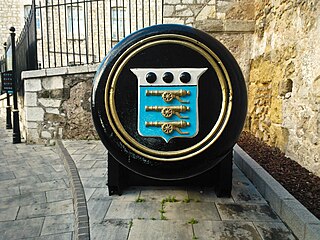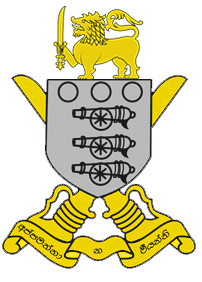
The Board of Ordnance was a British government body. Established in the Tudor period, it had its headquarters in the Tower of London. Its primary responsibilities were 'to act as custodian of the lands, depots and forts required for the defence of the realm and its overseas possessions, and as the supplier of munitions and equipment to both the Army and the Navy'. The Board also maintained and directed the Artillery and Engineer corps, which it founded in the 18th century. By the 19th century, the Board of Ordnance was second in size only to HM Treasury among government departments. The Board lasted until 1855, at which point it was disbanded.

Woolwich Dockyard was an English naval dockyard along the river Thames at Woolwich in north-west Kent, where many ships were built from the early 16th century until the late 19th century. William Camden called it 'the Mother Dock of all England'. By virtue of the size and quantity of vessels built there, Woolwich Dockyard is described as having been 'among the most important shipyards of seventeenth-century Europe'. During the Age of Sail, the yard continued to be used for shipbuilding and repair work more or less consistently; in the 1830s a specialist factory within the dockyard oversaw the introduction of steam power for ships of the Royal Navy. At its largest extent it filled a 56-acre site north of Woolwich Church Street, between Warspite Road and New Ferry Approach; 19th-century naval vessels were fast outgrowing the yard, however, and it eventually closed in 1869. The former dockyard area is now partly residential, partly industrial, with remnants of its historic past having been restored.

The Royal Arsenal, Woolwich is an establishment on the south bank of the River Thames in Woolwich in south-east London, England, that was used for the manufacture of armaments and ammunition, proofing, and explosives research for the British armed forces. It was originally known as the Woolwich Warren, having begun on land previously used as a domestic warren in the grounds of a mid-16th century Tudor house, Tower Place. Much of the initial history of the site is linked with that of the Office of Ordnance, which purchased the Warren in the late 17th century in order to expand an earlier base at Gun Wharf in Woolwich Dockyard.

The Royal Army Service Corps (RASC) was a corps of the British Army responsible for land, coastal and lake transport, air despatch, barracks administration, the Army Fire Service, staffing headquarters' units, supply of food, water, fuel and domestic materials such as clothing, furniture and stationery and the supply of technical and military equipment. In 1965 its functions were divided between other Corps and the RASC ceased to exist; subsequently, in 1993, they in their turn became the "Forming Corps" of the Royal Logistic Corps.

Woolwich Common is a common in Woolwich in southeast London, England. It is partly used as military land and partly as an urban park. Woolwich Common is a conservation area. It is part of the South East London Green Chain. It is also the name of a street on the east side of the common, as well as an electoral ward of the Royal Borough of Greenwich. The population of the ward at the 2011 Census was 17,499.

The Ministry of Supply (MoS) was a department of the UK government formed on 1 August 1939 by the Ministry of Supply Act 1939 to co-ordinate the supply of equipment to all three British armed forces, headed by the Minister of Supply. A separate ministry, however, was responsible for aircraft production, and the Admiralty retained responsibilities for supplying the Royal Navy. During the war years the MoS was based at Shell Mex House in The Strand, London.
Royal Ordnance Factories (ROFs) was the collective name of the UK government's munitions factories during and after the Second World War. Until privatisation, in 1987, they were the responsibility of the Ministry of Supply, and later the Ministry of Defence.

Woolwich Garrison is a garrison or station of the British Army. Geographically it is in Woolwich, in the London Borough of Greenwich. In terms of command, it is within the Army's London District.

The Royal Army Veterinary Corps (RAVC), known as the Army Veterinary Corps (AVC) until it gained the royal prefix on 27 November 1918, is an administrative and operational branch of the British Army responsible for the provision, training and care of animals. They are also responsible for explosives and drug search dogs. It is a small corps, forming part of the Army Medical Services.

The Royal Army Ordnance Corps (RAOC) was a corps of the British Army. At its renaming as a Royal Corps in 1918 it was both a supply and repair corps. In the supply area it had responsibility for weapons, armoured vehicles and other military equipment, ammunition and clothing and certain minor functions such as laundry, mobile baths and photography. The RAOC was also responsible for a major element of the repair of Army equipment. In 1942 the latter function was transferred to the Royal Electrical and Mechanical Engineers (REME) and the vehicle storage and spares responsibilities of the Royal Army Service Corps were in turn passed over to the RAOC. The RAOC retained repair responsibilities for ammunition, clothing and certain ranges of general stores. In 1964 the McLeod Reorganisation of Army Logistics resulted in the RAOC absorbing petroleum, rations and accommodation stores functions from the Royal Army Service Corps as well as the Army Fire Service, barrack services, sponsorship of NAAFI (EFI) and the management of staff clerks from the same Corps. On 5 April 1993, the RAOC was one of the corps that amalgamated to form The Royal Logistic Corps (RLC).

The United States Army Ordnance Corps, formerly the United States Army Ordnance Department, is a sustainment branch of the United States Army, headquartered at Fort Gregg-Adams, Virginia. The broad mission of the Ordnance Corps is to supply Army combat units with weapons and ammunition, including at times their procurement and maintenance. Along with the Quartermaster Corps and Transportation Corps, it forms a critical component of the U.S. Army logistics system.

Branston is a village and civil parish in Staffordshire, England. At the 2001 census, the population was 6,540, increasing to 6,749 at the 2011 Census.

Brigadier-General Harold Stephen Langhorne was an officer in the Royal Army Ordnance Corps of the British army and served in India, Burma, Hong Kong, South Africa and France.

The Sri Lanka Army Ordnance Corps (SLAOC) is a combat support corps of the Sri Lanka Army. The role of the corps is the procurement, receipt, storage, accounting, maintenance, control, issue and disposal of ordnance stores. It is made up of seven regular ordnance battalions, three Base Depots, one volunteer (reserve) ordnance battalion, and many independent ordnance depots. It is headquartered at the Regimental Centre, Dombagoda.

A Royal Naval Armament Depot (RNAD) is an armament depot dedicated to supplying the Royal Navy. They were sister depots of Royal Naval Cordite Factories, Royal Naval Torpedo and Royal Naval Mine Depots. The only current RNAD is RNAD Coulport, which is the UK Strategic Weapon Facility for the nuclear-armed Trident Missile System; with many others being retained as tri-service 'Defence Munitions' sites.

Branston Depot is a former ordnance facility at Branston, Staffordshire.
Norman Joseph Levien (1871–1967) was a New Zealand Army Officer and a foundation member of the New Zealand Army Ordnance Corps who served in Egypt, Gallipoli and Europe during the First World War.

The Naval Ordnance Department, also known as the Department of the Director of Naval Ordnance, was a former department of the Admiralty responsible for the procurement of naval ordnance of the Royal Navy. The department was managed by a Director, supported by various assistants and deputies; it existed from 1891 to 1958.

The Naval Ordnance Stores Department, was a former department of the Admiralty responsible for the management of naval ordnance storage facilities and depots of the Royal Navy the department was managed by a Superintendent of Stores supported by various deputy and assistant superintendents's it existed from 1891 to 1918 when it was replaced by the Armament Supply Department.

















